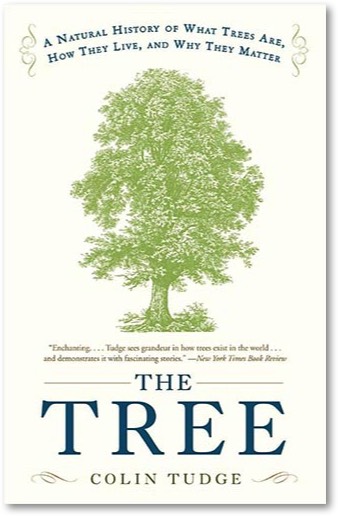
Musings » The Tree; a natural history of what trees are, how they live and why they matter


New York
Crown Publishers 2006
Trees are full of secrets. Under their serene and placid beauty complex machinery works fiendishly hard to maintain the long supply lines. In Oak: the frame of civilization William Logan devoted many pages to the extraordinary difficulties the forester faces in deciding when to cut a tree down and having done it, whether in fact it yielded the good timber he expected. He simply could not tell from the outside even after years of experience.
Colin Tudge has had a long and distinguished career in science writing. He has made a special study of genetics and evolution. In Mendel’s Footnotes is just one of his books. His work is deeper than just popularizing. He is a true interface between difficult basic concepts and research and the public. In this book, The Tree, he brings an easy style born of rich understanding and broad knowledge to a generic topic. How, after all, does one cover everything to do with all those massive organisms which populate the earth? The problem lies in sorting the material.
Tudge offers introductory sections on what trees have in common with all living things. He opens with a chapter headed ” Trees in Mind; simple questions with complicated answers”. He asks, “what is a tree?” and perhaps a trifle disingenuously answers himself by saying it is a big plant with a stick up the middle. This takes us all the way back to kindergarten.
He points out that trees do not move, that trees are parts of families of plants and that they have enormous difficulty competing on a continuous basis for survival. Reproducing itself is one the hardest things a tree can do. One follows along with him very comfortably. Much of what he says makes excellent sense and a few of his counter- intuitive insights break up any sense of complacency. I thought the content would be excellent for my 13 year old grandson.
Just as I was settling in for the ride he hit us with cladistics. The classification of plants has been changing out of all recognition over the past twenty years. With each generation of taxonomists, new methods have been employed to improve our understanding of how plants are related. In my recent notes about the iris I commented that the classification of this plant has changed due to the use of DNA tests.
Tudge now tells us that even DNA has flaws and is not the final word. Enter cladistics. This is not the place to define it but cladistics takes us from the 8th grade to post-graduate level. The reason I comment on this at some length is the old question for whom the book is intended. It may be that I am out of touch and that cladistics are taught in junior high school.
In the following sections Tudge takes us on a glorious journey around the world, looking at many families of trees and their habitats. Once again it is a mixture of the well- known and the unexpected. One still has the feeling that he is writing well within himself, jogging along easily atop of great depth.
Foresters are the sensible custodians of the forests, caught up in mundane tasks. They do not sit open-mouthed under their trees and wonder about their place in the biological world. This is what Colin Tudge invites us to do in his book. Other writers, such as Thomas Pakenham, have praised rare arboreal specimens, treating ancient trees as if they were human individuals. There is a baobab tree in India which occupies a solid acre with its auxiliary aerial roots. As people become more and more concerned about the wild environment, Tudge’s book serves a very useful purpose. It anchors occasionally fluffy ideas in solid reality.
One small cavil: I wish the editor had been a little more assertive. Page after page with phrases and sentences uselessly clothed in parentheses become annoying after a while. This stylistic quirk is present in his other books but it interferes with the enjoyment of his work.

